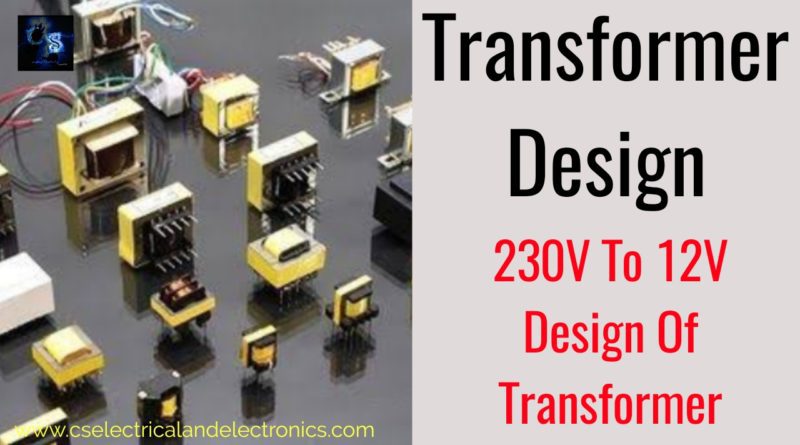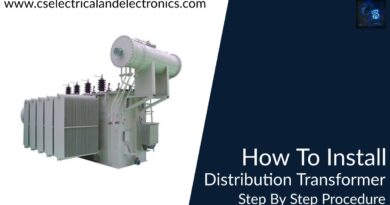Transformer Design, 230 V to 12 V Step Down Transformer, Materials
Hello guys, welcome back to my blog. In this article, I will discuss the transformer design, how to design 12 volts transformer, materials required to design a transformer, etc.
If you require an article on some other topics then comment us below in the comment box. You can also catch me @ Instagram – Chetan Shidling.
Also, read:
Transformer Design
Construction of the transformer
The transformer consists of two inductive windings and also a laminated sheet core. The windings will be insulated from each other and also from the steel core. The core is made up of Silicon steel that is assembled to provide a continuous magnetic path for flux. By this laminated core, Eddy current losses are minimized. The thickness of laminated sheets is 0.35 mm to 5mm which are insulated with varnish, oxide, or phosphate, which will be formed as the core.
The transformer contains two windings named primary and secondary windings that are made up of high-grade copper. The voltage connected to the primary winding is called the primary voltage, and the secondary winding voltage is called the secondary voltage. If secondary voltage is more than the primary voltage, then it is called a step-up transformer, And if it is less, then it’s said to be a step-down transformer.
Because of this, the windings are considered as HV winding and LV winding based on the level of voltage. HV winding needs more insulation to withstand high voltages. The coils can be concentric and sandwiched coils. Concentric coils will be used in core type, while the sandwiched coils will be used in shell type transformers.
The other parts of the transformers are conservator tank, which will be used to provide oil storage, such that the pressure of the oil under heavy loads settles down. Bushings will be provided to give insulation to the output terminals that will be taken from the windings of the transformer. In 12 volts transformer, these other parts will not be present. The efficiency of the transformer will be very high which varies from 95% to 98%.
How To Construct Step Down Transformer At Home?
Let’s see how to do a transformer at home without using any type of machine. Here I’m going to discuss how to construct 12V, 2A step-down transformer.
The things which you need to do this transformer are,

- Coil (SWG-37 copper wire, SWG-25 copper wire).
- Masking tape.
- Moisture resistance paper/wax paper.
- Multimeter.
- 220AC supply.
How to Calculate secondary turns with assumed turns of primary winding?
- Consider, I will take 2000 turns towards the primary side for 220V AC supply,
- Then the primary turns per each volt = 2000/220 = 9.09 turns/V
- Then secondary turns should be = 12×9.09= 109.09 turns.
How to wound primary winding:
For the primary winding make use of SWG 37 copper wire, and you have to buy primary copper wires according to weight. To create the primary core you have to wrap SWG-37 wire around the core. But the question comes how many turns we have to take?. It depends upon the voltage value of the transformer here I’m showing the construction of 12V, 2A transformer, that’s why I will take 2000 primary turns and I will wrap on the coil. But you have to keep two ends of the copper wire-free, Then you have to solder to external patch cords to these both ends by using solder gun, for connection to the power source.
Then you have to wrap with masking tape to place primary winding with tight. After that take heat and moisture resistance paper instead of this paper you can also use wax paper. Then wrap this moisture paper on the primary winding to keep the insolation between primary and secondary windings.
Once again wrapped with masking tape to make it tight. If you leave a gap then secondary and primary windings may come in contact with each other. So you have to wrap properly.
How to wound secondary winding
For the secondary winding take SWG-25 copper wire. Here we are discussing a step-down transformer which means secondary turn should be less than primary turns. So for the 12 Volt transformer, we have to take 109 turns on the secondary side, And wound it on the same coil, keeping two ends free to give output. Then you have to solder to external Patch cord to both these ends. Again wrap with wax paper that will be again wrapped by masking tape.
Now we have wounded secondary and primary winding’s successfully.
Note: you can wound wires in any direction, either in clockwise or in anticlockwise.
How to check resistance value of each winding?
You can check the resistance of both windings for using a multimeter. In our case, the resistance of the primary winding should be 35 ohms. For the secondary winding, the resistance should be between 2 to 3 ohms.

At last, the constructed coil should be fixed with courts which will be made up of iron sheets in the shape of E and I. You have to insert these cores properly in the coil. Then place an external frame on this core.
Now you can check voltage of your transformer by using multi-meter.
Give the two free ends of the primary winding to this supply of 220v AC, and connect another two free ends of the secondary winding to the multimeter. Keep your multimeter in AC supply mode, then connect multimeter patch cords to secondary free ends to measure the voltage of transformer. Now you will get voltage of the transformer as 12V.
I hope this article may help you all a lot. Thank you for reading. If you have any doubts related to the transformer design then comment below.
Also, read:
- 10 Tips To Maintain Battery For Long Life, Battery Maintainance
- 10 Tips To Save Electricity Bills, Save Money By Saving Electricity
- 100 (AI) Artificial Intelligence Applications In The Automotive Industry
- 100 + Electrical Engineering Projects For Students, Engineers
- 1000+ Control System Quiz, Top MCQ On Control System
- 1000+ Electrical Machines Quiz, Top MCQs On Electrical Machines
- 1000+ MATLAB Simulink Projects For MTech, Engineering Students
- 50 Tips To Save Electricity At Home, Shop, Industry, Office
- 50+ Question And Answer On The Substation, Electrical Question
- 500+ Matlab Simulink Projects Ideas For Engineers, MTech, Diploma
- 500+ Projects For Diploma Electrical, Electronics Student, Diploma Project
- Active Cell Balancing Using A Flyback Converter Simulation In Matlab Simulink
- AI Artificial Intelligence Applications In Electric Vehicles | Future?
- AI Tools For Electronic Circuit Design, Which Is Best?
- Applications Of Artificial Intelligence (AI) In Renewable Energy
- Automotive Industry Or VLSI Chip Industry ? Which Is Best?
- Basic Electrical Engineering, Terms, Definitions, SI Unit, Formula
- Basic Electrical Quiz, Take Online Test On Basic Electrical, Electrical Quiz
- Battery C Rate Online Calculator With Time Calculation
- Battery Management Systems In Electric Vehicles, BMS Operations
Author Profile
- Chetu
- Interest's ~ Engineering | Entrepreneurship | Politics | History | Travelling | Content Writing | Technology | Cooking
Latest entries
 All PostsApril 13, 2024What Is TCM, Transmission Control Module, Working, Purpose,
All PostsApril 13, 2024What Is TCM, Transmission Control Module, Working, Purpose, All PostsApril 12, 2024Top 100 HiL hardware in loop Interview Questions With Answers For Engineers
All PostsApril 12, 2024Top 100 HiL hardware in loop Interview Questions With Answers For Engineers All PostsMarch 22, 2024Driver Monitoring Systems In Vehicles, Working, Driver Sleepy Alert
All PostsMarch 22, 2024Driver Monitoring Systems In Vehicles, Working, Driver Sleepy Alert All PostsMarch 10, 2024Top 100 Automotive Interview Questions With Answers For Engineers
All PostsMarch 10, 2024Top 100 Automotive Interview Questions With Answers For Engineers








